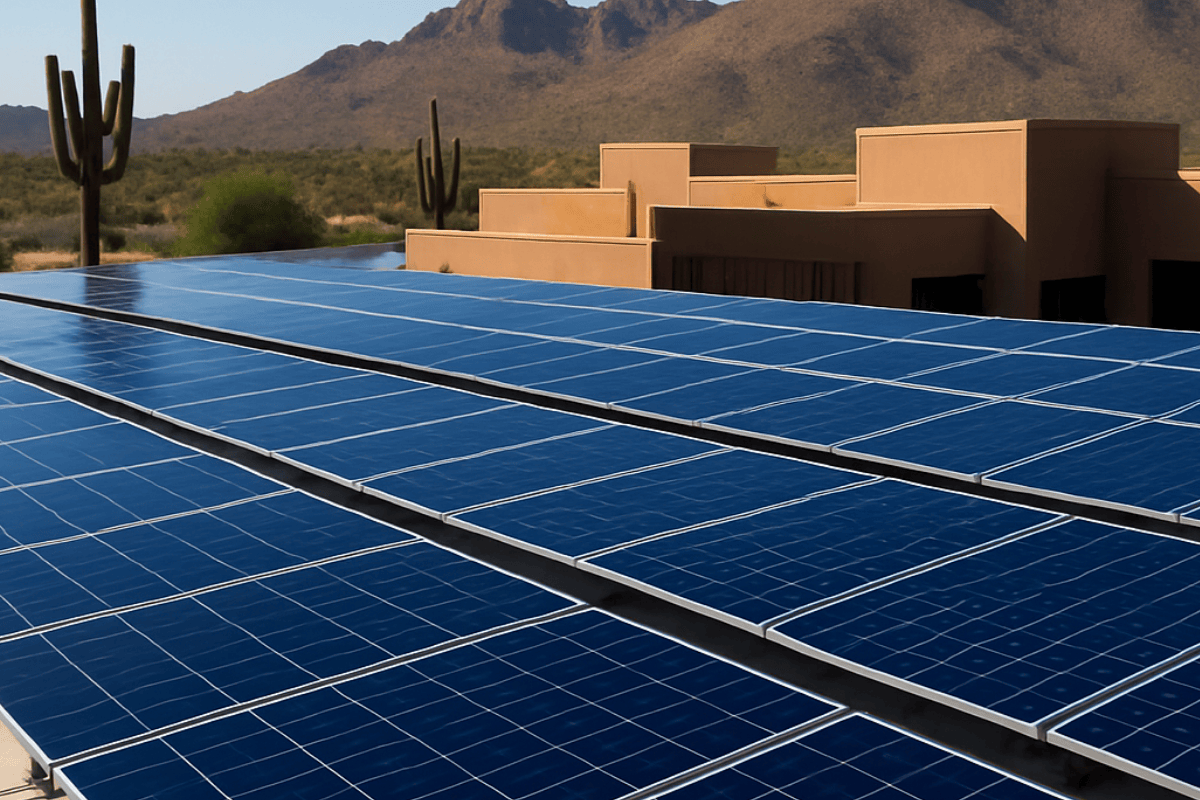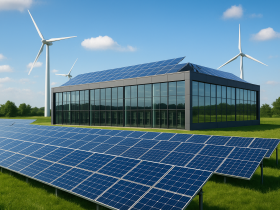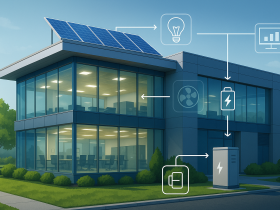Arizona averages more than 300 sunny days each year, making it one of the best places in the country for solar power generation. In 2026, this unmatched solar potential continues to drive business interest in clean energy, but new policies and shifting market dynamics are changing how commercial solar projects are planned and financed across the state.
From updated net billing rules to the repeal of the state’s Renewable Portfolio Standard, Arizona’s commercial solar sector is entering a new phase. Businesses are acting strategically to manage energy costs, meet sustainability goals, and adapt to evolving regulations.
At the same time, local companies like Saguaro Solar, a commercial solar company in Arizona, are helping organizations navigate these changes with tailored energy solutions.
In this article, we’ll break down the most important developments shaping the future of commercial solar in Arizona in 2026:
- Why Arizona remains a top-tier location for commercial solar energy generation
- How recent policy changes are reshaping incentives and solar economics
- The most effective system types and installation approaches businesses are using
- Key financial tools and tax benefits available for commercial solar projects
- Challenges facing the sector and how businesses are overcoming them
By the end of this post, you’ll understand the key trends in Arizona commercial solar and how companies can stay ahead by planning smart, leveraging incentives, and working with experienced local providers.
Arizona’s Solar Advantage in 2026
Arizona continues to lead the nation in solar potential, offering businesses unmatched conditions for generating clean, affordable electricity. With more than 300 sunny days per year, the state’s unique climate and geography make it a powerhouse for solar generation, especially in the commercial sector.
Solar Resource Abundance
The foundation of Arizona’s solar appeal lies in its solar irradiance levels. The state’s high levels of direct sunlight mean that photovoltaic (PV) systems installed on commercial properties generate more electricity per panel than in most other parts of the country. This leads to faster payback periods and higher long-term returns on investment.
- Over 300 sunny days annually
- High solar irradiance improves energy yield
- Consistent performance year-round due to minimal cloud coverage
For businesses evaluating long-term energy investments, this abundance translates directly into lower utility bills and improved energy independence.
Market Capacity and Large-Scale Potential
Arizona has already proven its capacity for large-scale solar generation. Projects like the 280 MW Solana Generating Station, which uses concentrated solar power (CSP) with molten salt storage, showcase the state’s ability to support both photovoltaic and thermal solar technologies on a massive scale.
According to industry analysis, Arizona has the physical and solar resource capacity to host thousands of gigawatts of PV and CSP, far exceeding current demand. This positions the state as a long-term hub for clean energy development.
Policy and Regulatory Changes Impacting 2026
While Arizona’s natural solar potential remains strong, 2026 brings significant policy shifts that affect how businesses approach commercial solar. Regulatory changes are altering the incentive landscape and reshaping how solar systems interact with the grid.
Repeal of the Renewable Portfolio Standard (RPS)
In 2025, the Arizona Corporation Commission (ACC) voted to repeal the state’s Renewable Portfolio Standard, which had previously required utilities to source 15% of their energy from renewables by 2025. This repeal removes a key driver of utility-scale solar investment and has ripple effects on commercial projects that relied on utility incentives tied to RPS compliance.
Without the RPS, businesses must rely more heavily on federal incentives and direct financial returns to justify solar investments. Strategic planning becomes more important than ever to maximize system value.
Net Metering vs. Net Billing
Arizona has shifted away from traditional net metering toward net billing, where solar system owners are compensated at a lower, often wholesale, rate for excess electricity sent to the grid. This change impacts the economics of commercial solar, reducing the value of exported energy.
- Net billing reduces payback for oversized systems
- Emphasizes the importance of right-sizing systems to match on-site consumption
- Encourages energy storage to maximize on-site usage
Understanding rate structures and working with experienced providers is critical to designing cost-effective systems under the new rules.
Solar Rights and Permitting Laws
Arizona remains one of the most solar-friendly states in terms of property rights. Laws prevent homeowners’ associations (HOAs) and other entities from banning solar installations entirely. For commercial projects, permitting is more complex, involving building codes, electrical standards, and sometimes utility interconnection agreements.
- Arizona Revised Statutes (ARS) protect solar access rights
- Businesses must navigate local permitting processes
- Experienced contractors help avoid delays and compliance issues
System Types and Installation Trends in Arizona
As businesses adopt solar in 2026, a variety of system types and deployment methods are being used to meet site-specific needs and energy goals.
Rooftop, Ground-Mounted, and Solar Carports
Commercial solar installations in Arizona typically fall into one of three categories:
- Rooftop systems: Ideal for warehouses, retail buildings, and offices with flat or low-slope roofs
- Ground-mounted arrays: Suited for businesses with ample unused land, such as manufacturing facilities
- Solar carports: Provide dual benefits of shaded parking and power generation, popular in schools, hospitals, and corporate campuses
Each system type has unique design and engineering considerations. Site constraints, local zoning rules, and energy consumption patterns influence the best choice for each business.
Energy Storage and Smart Integration
Battery storage is becoming a core component of commercial solar systems in Arizona. As grid compensation decreases under net billing, storing excess energy for later use increases system value and reliability.
- Batteries help manage demand charges during peak times
- Improve energy resilience during outages
- Support time-of-use arbitrage under variable rate structures
Integrating solar with energy management software also allows businesses to optimize usage patterns and improve ROI.
Turn-Key EPC Services
To simplify the process, many businesses are turning to turn-key engineering, procurement, and construction (EPC) providers. These companies manage the entire project lifecycle from design and permitting to installation and system commissioning.
- Streamlined project management
- Faster timelines and fewer permitting issues
- Single point of accountability
Working with a full-service provider ensures consistency and reduces the risk of cost overruns or delays.
Financial Outlook and Incentives in 2026
Despite policy shifts, commercial solar in Arizona remains financially attractive in 2026 due to a variety of federal incentives and financing mechanisms.
Federal and State Tax Credits
The 30% Investment Tax Credit (ITC) continues to be a major financial driver for commercial solar. While Arizona’s state credit is limited and primarily benefits residential users, the federal ITC significantly reduces upfront costs.
- 30% federal ITC applies to total system cost
- Must be claimed in the year the system is placed in service
MACRS and Bonus Depreciation
The Modified Accelerated Cost Recovery System (MACRS) allows businesses to depreciate the cost of a solar system over five years, with bonus depreciation available for systems installed in 2026.
- Accelerated depreciation improves cash flow
- Can reduce tax liability in the early years of system operation
Timing installations to align with fiscal planning can enhance financial outcomes.
Financing Options for Businesses
Commercial solar buyers in Arizona have multiple financing options:
- Loans: Allow businesses to own the system and claim all tax benefits
- Leases: Reduce upfront costs but shift tax credits to the lessor
- Power Purchase Agreements (PPAs): Third-party ownership models with predictable electricity prices over time
Each model has trade-offs in terms of ownership, savings, and tax benefits. A qualified financial advisor or solar provider can help determine the best fit.
Market Challenges and How to Overcome Them
Regulatory Uncertainty and Grid Compensation
The shift to net billing and the repeal of the RPS have introduced uncertainty around long-term solar economics. Businesses must model different compensation scenarios and design systems to prioritize on-site usage.
- Focus on self-consumption to maximize value
- Monitor regulatory developments and rate case outcomes
- Use storage to reduce grid reliance
Permitting Complexity
Commercial solar projects often require multiple layers of permitting and utility approval. Navigating this process efficiently is key to avoiding costly delays.
- Work with experienced EPC firms familiar with Arizona jurisdictions
- Ensure all designs meet current building and electrical codes
- Factor permitting timelines into project schedules
Cost and Infrastructure Integration
Some facilities need electrical upgrades or structural modifications to support solar installations. These costs can add complexity but are manageable with proper planning.
- Conduct thorough site evaluations upfront
- Use system design to minimize costly upgrades
- Explore financing tools to spread out capital costs
Environmental and Economic Impact
Cost Savings and Energy Independence
By producing their own electricity, businesses reduce their exposure to utility rate hikes and lower their long-term operating costs.
- Hedge against rising utility prices
- Reduce peak demand charges
- Improve budget predictability
Emissions Reduction and Sustainability Branding
Commercial solar supports corporate environmental, social, and governance (ESG) goals by reducing carbon emissions and demonstrating a commitment to sustainability.
- Appeal to eco-conscious customers and stakeholders
- Meet internal ESG or carbon neutrality targets
- Qualify for green certifications and procurement programs
Job Creation and Local Economic Benefits
Arizona’s solar industry supports thousands of jobs in installation, engineering, manufacturing, and maintenance. Commercial projects contribute to this economic activity and help build a skilled local workforce.
Planning for the Future of Solar in Arizona
Arizona’s commercial solar market in 2026 is defined by its unmatched solar potential, shifting incentive structures, and growing demand for clean energy solutions. Businesses that act strategically can secure long-term savings and environmental benefits.
- Arizona remains one of the most solar-rich states in the country
- Policy changes require businesses to evaluate financial models carefully
- Local expertise is essential to navigating permitting, design, and financing
By partnering with experienced providers and staying informed about policy developments, companies can successfully adopt commercial solar in Arizona and position themselves for a sustainable future.
Citations
- Solar Power in Arizona – Wikipedia
- Solar Policy Scoop – Solar Power World
- Net Metering in Arizona – Wikipedia
- Arizona Solar Panel Laws – Our World Energy
- Solar Power in the United States – Wikipedia
- Know Your Rights – Arizona Solar Center
- Global Solar Energy – Wikipedia
- Arizona Regulators Move to Repeal Renewable Energy Standard – Power Engineering
- Arizona Regulators Begin Process to Repeal Renewable Standard – Utility Dive




